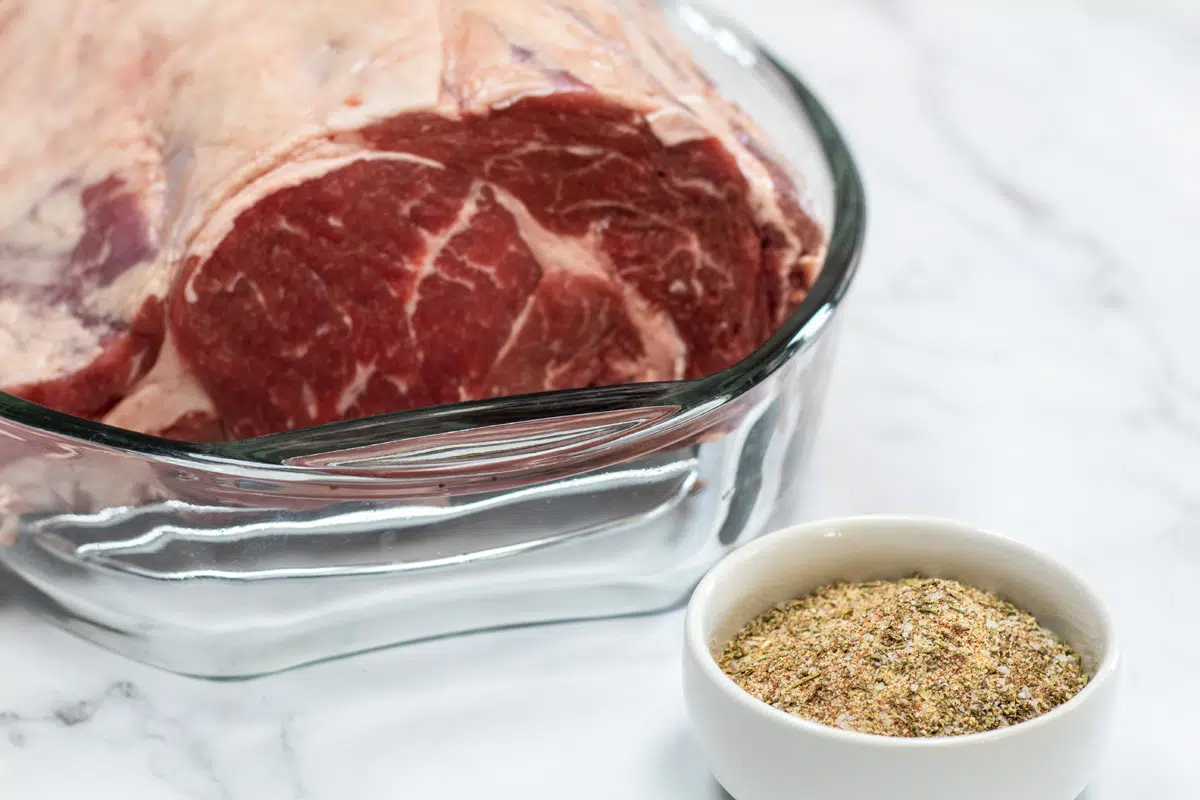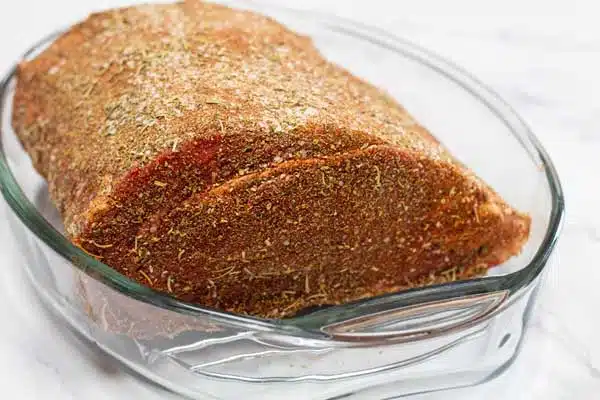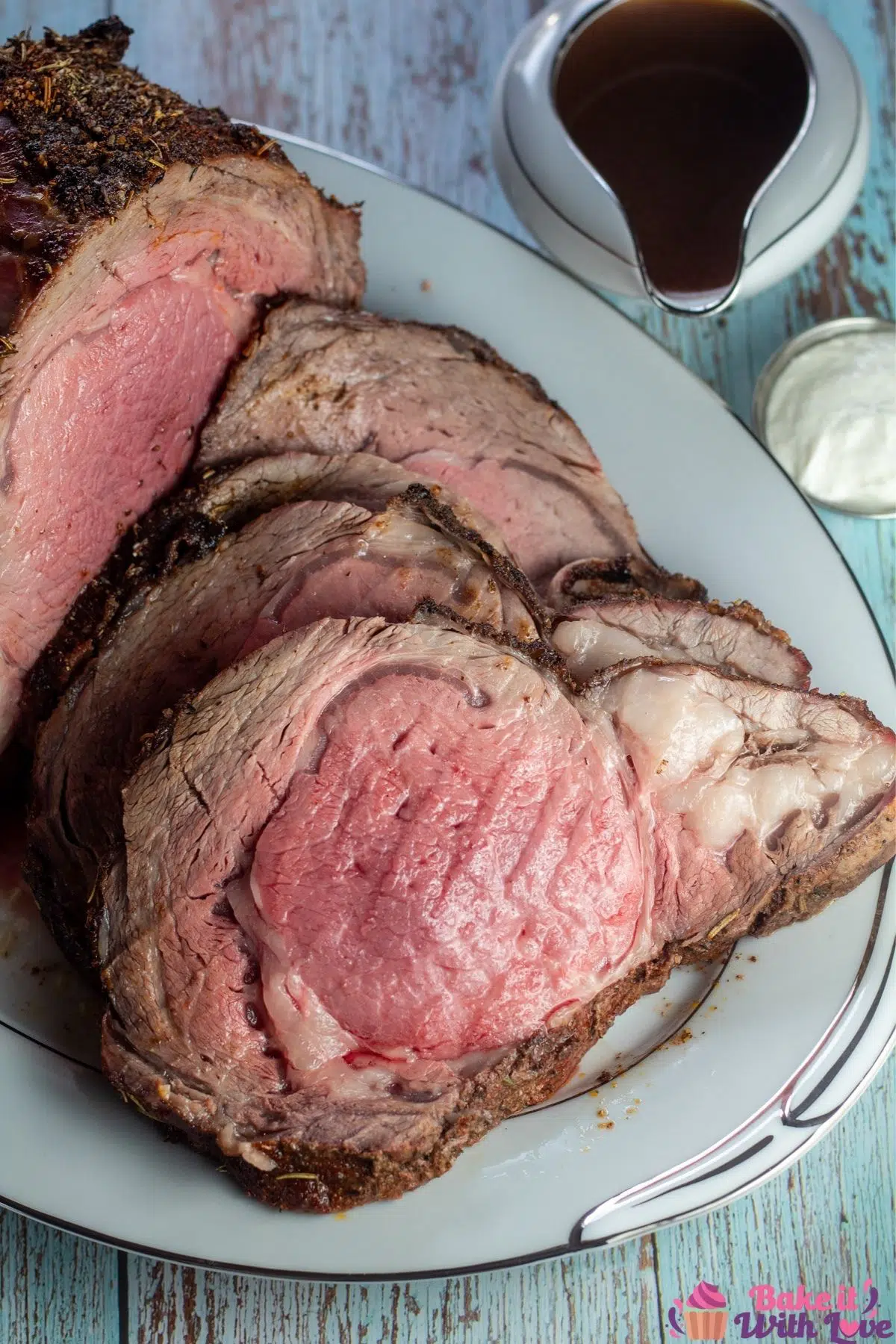This boneless prime rib roast is tender and juicy. It is the perfect showstopping main course that family and friends will rave about. It is never tough, delivers a TON of incredible flavor, and is so easy to make. Prepare this roast for an unforgettable dinner.
Serve this delicious main course with favorite sides – mashed potatoes, cheddar bacon chive biscuits, green beans, and my sticky-sweet candied yams. Enjoy!

Jump to:
Craving an amazing prime rib recipe for the holidays? My boneless prime rib is perfect. This prime rib recipe is succulent, flavorful, and melt-in-your-mouth tender!
This recipe is not only delicious, but it’s so much easier than you might expect. Don’t be intimidated by the thought of cooking this tasty cut of beef – my tips and tricks will turn you into a pro!
Perfectly roasted prime rib is a must-have for Christmas dinners and a regular in our holiday meals (along with spiced goose). I hope that you enjoy your dinner as much as we do.
Before you get started, make sure you know how to select the best prime rib roast!
Whether you're a pro at hosting Christmas dinner and holiday parties or giving it a try for the first time this year, you're sure to find my ultimate guide to planning Christmas a help! Don't forget to safely thaw your holiday prime rib early, too!
🥘 Ingredients
Make the holidays even better with this simple recipe, with a delicious rub you can use on almost any red meat.

Boneless Prime Rib Roast
- Prime Rib – 5-pound prime rib. We’re using a boneless roast for this recipe, but this technique can also be applied to a standing rib roast. Ask your grocery store’s butcher for help if you need it! *Note that smaller or larger roasts will cook for approximately 45 minutes per pound.
Prime Rib Rub Seasoning
- Kosher Salt – 1½ tablespoons of kosher salt. I love using Kosher salt in this recipe because the flakes of salt evenly cover the meat, so the entire roast is perfectly seasoned.
- Coarse Ground Pepper – 1 tablespoon of coarse ground pepper. Freshly ground is best for this recipe. You’ll want coarsely ground black pepper so the flavor stands up to the meat and the rest of the seasonings.
- Garlic Powder – ½ tablespoon of garlic powder. Every roast needs garlic powder, in my opinion! Be sure not to use garlic salt so the meat doesn’t become too salty.
- Smoked Paprika – 1 teaspoon of smoked paprika. You can also use regular paprika for this recipe. I like to use smoked paprika because it lends the roast an incredible slightly smoky, slightly sweet flavor.
- Dried Rosemary – 1 teaspoon of dried rosemary. Rosemary adds an aromatic, herbal note to the rub. You can use fresh rosemary if you prefer, but be sure to mince it finely so it doesn’t burn.
- Ground Sage – 1 teaspoon of ground sage. Ground sage is perfect in this rub! It adds that distinct herby flavor we all love around the holidays.
- Dried Thyme – 1 teaspoon of dried thyme. Thyme gives a sweet, lemony flavor to the rub. The dried thyme is perfect, but if you prefer, you can use fresh thyme as well.
- Dried Oregano – ½ teaspoon of dried oregano. Dried oregano is the final herb in this rub and balances out the flavor with its spicy richness.
- Onion Powder – ½ teaspoon of onion powder. Onion powder adds that fabulous depth of flavor! You can use either granulated onion or onion powder.
*Be sure to see the free printable recipe card below for ingredients, exact amounts & instructions with tips!*
🔪 How To Cook A Boneless Prime Rib
This recipe will yield 10 servings; plan for about ½ lb per person.

- Prep Prime Rib. Rinse your 5-pound boneless prime rib roast in cool running water, then pat dry with paper towels. Be sure to sanitize your sink afterward!
- Finish Prepping Prime Rib. Remove any excess fat or silver skin/connective tissue, if desired. If you wish, you can tie off the rib roast with butcher twine every 1½ inches down the length of the roast.
- Make Rib Rub. In a small bowl, combine the dry rub ingredients: 1½ tablespoons of Kosher salt, 1 tablespoon coarse ground pepper, ½ tablespoon garlic powder, 1 teaspoon smoked paprika, 1 teaspoon dried rosemary, 1 teaspoon ground sage, 1 teaspoon dried thyme, ½ teaspoon dried oregano, and ½ teaspoon onion powder. Mix well and set aside.
- Season Prime Rib. Place the prime rib on a baking sheet or baking dish and sprinkle the dry rub all over, using about half the rub for each side. Using clean hands, massage the dry rub into the meat and roll the edges in any excess that has fallen onto the baking sheet. The entire surface should be fully coated! *Don’t be shy with the seasoning!
- Allow Prime Rib to Dry Brine. Once the prime rib is fully seasoned, leave uncovered and transfer it to your fridge to dry brine overnight or at least 8 hours. For the best results, allow the prime rib to come up to temperature (no more than two hours) before roasting.
- Roast Prime Rib. Preheat your oven to 200°F (93°C). Then, transfer the seasoned prime rib roast to a roasting pan and put it in the preheated oven (fat side facing up for a boneless prime rib or bone side down for a standing rib roast). Roast for 3 hours and 45 minutes, or about 45 minutes per pound of meat, until the internal temp reaches the desired level of doneness.
- Bring Roast to Desired Temp. Bring the roast to an internal temperature of 120-125°F (49-52°C) for rare, 125-129°F (52-54°C) for medium rare, 130-139°F (54-59°C) for medium or 140-145°F (60-63°C) for medium done. Then remove the roast from the oven and allow it to rest, tented loosely with a piece of aluminum foil for 20 to 30 minutes before carving and serving.
Optional Reverse Sear
- Remove Roast. If you’d like to reverse sear your prime rib roast, remove the roast at about 10°F (5.5°C) below the desired temperature. Then, transfer the roast to a cutting board or platter and cover it with aluminum foil while you bring your oven temperature to 500°F (260°C).
- Reverse Sear. Once your oven is fully preheated, return the roast and cook until the internal temperature is 130°F (54°C) for rare, 135°F (57°C) for medium rare, and 140°F (60°C) for medium. *Keep a close eye on your prime rib as this searing step moves along quickly!
- Finish. Remove your prime rib from the oven, place a sheet of aluminum foil over the roast, and allow it to rest for at least 15 minutes and up to 30 before carving.

💭 Angela's Pro Tips & Recipe Notes
- Securing the Rib Roast: For easier carving and to maintain its shape, consider tying the rib roast with clean, cotton twine at 1½ inch intervals. This is particularly useful for a standing rib roast. Place the roast in the oven with the knots facing down, but ensure the twine isn't too tight to prevent juice loss.
- Dry Brining for Flavor: Let the roast undergo a 'cure' or 'dry brine' process for optimal flavor. Season the roast, then wrap it in plastic cling film for a minimum of 4 hours, or leave it unwrapped on a baking sheet in the refrigerator overnight.
- Safe Refrigeration Practices: When dry brining, especially if leaving the meat uncovered, place it on the lowest shelf of your refrigerator to avoid cross-contamination with other foods, particularly produce.
- Using a Meat Thermometer: Always use a meat thermometer to ensure the prime rib reaches the desired internal temperature. Check the temperature in the thickest part of the roast and several spots near the center for an accurate reading.
- Accounting for Carryover Cooking: Remember, the roast's temperature will continue to rise by about 5-7°F (3-4°C) due to carryover cooking after it's removed from the oven. Remove the roast from the oven early based on your preferred level of doneness to accommodate this increase.
🥡 Storing & Reheating
Make sure to tightly wrap the leftover roast in plastic wrap and/or an airtight container and keep it in the fridge.
You can also double-wrap the leftovers to make sure they stay moist. It’ll last for about 5 to 7 days in the fridge for the best quality.
To freeze, make sure the prime rib is completely cooled, then wrap the prime rib in plastic wrap and place it in a freezer storage bag or airtight freezer container. it’ll keep for about 6 months.
You can also freeze individual portions or portions needed for future meals. Freeze the plastic cling film-wrapped pieces separately, then place them into a freezer storage bag.
This is my preferred method, as I have many amazing leftover recipes. So, you can see my notes below on reheating - but know that each leftover recipe I share here on Bake It With Love will tell you the best way to reheat your leftover prime rib.
Check out my posts on how long will leftover prime rib last, how long can you keep prime rib in the freezer, and how long can you keep thawed prime rib in the fridge.
Reheating
Before getting started, if your prime rib is frozen, make sure you know how to safely thaw it out.
Reheating prime rib is an art! Place the leftovers in a pan, add a few splashes of beef broth, and then cover with foil and bake at 300°F (150°C) for 20 to 30 minutes.
Note the USDA recommends leftover meat be reheated to 165°F (74°C), which is well above medium rare temperature.

❓ Recipe FAQs
A reverse sear is when you increase the oven’s temperature after roasting a piece of meat and let it cook at a high temperature for a few minutes to make the outside delightfully golden brown and crisp. It’s a great method to use on this prime rib so that the exterior crust is given maximum flavor!
Leftover prime rib recipes are my specialty! Try my recipes for cheesy leftover prime rib burritos, amazing prime rib pasta, prime rib stroganoff, or even prime rib chili! Check out my Leftover Prime Rib Recipes post for even more delicious ideas!
I love prime rib, but do want to switch it up? Try my incredible smoked prime rib recipe! It’s just as tasty but also has an amazing smoky flavor to knock your socks off!
😋 What To Serve With Prime Rib
Need some ideas on what sides to serve with your prime rib? Here are a few great accompaniments!
- Creamy Horseradish Sauce - This tasty sauce perfectly accompanies any prime rib dish.
- Au Jus or Red Wine Au Jus - Dip your roast in this delicious au jus sauce for a special finishing touch.
- Fondant Potatoes - These sophisticated potatoes are rich, decadent, and the perfect side dish for your roast.
- Yorkshire Puddings - These unique dinner rolls are sure to be a family favorite.
- Brown Sugar Glazed Carrots - Try these sweet glazed carrots for a classic vegetable side dish.
- Roasted Brussel Sprouts - Roasted brussel sprouts are easy to make and wonderfully delicious.
Do you love a recipe you tried? Please leave a 5-star 🌟rating in the recipe card below and/or a review in the comments section further down the page.
Stay in touch with me through social media @ Pinterest, Facebook, Instagram, or Twitter! Subscribe to the newsletter today (no spam, I promise)! Don't forget to tag me when you try one of my recipes!
📖 Recipe Card
Boneless Prime Rib
Ingredients
Boneless Prime Rib Roast
- 5 lb prime rib (boneless roast)
Prime Rib Rub
- 1 ½ tablespoon kosher salt
- 1 tablespoon coarse ground pepper (freshly ground is best)
- ½ tablespoon garlic powder
- 1 teaspoon smoked paprika (or regular paprika)
- 1 teaspoon dried rosemary
- 1 teaspoon ground sage
- 1 teaspoon dried thyme
- ½ teaspoon dried oregano
- ½ teaspoon onion powder
(Note: 2x or 3x only changes the ingredient list)
Instructions
Preparation
- Rinse your 5 lb prime rib roast in cool running water, and pat dry with paper towels. Remove any excess fat or silver skin, if desired.
- (optional) Tie the rib roast with butcher twine. For boneless roasts, tie every 1.5 inches down the length of the roast.
Prime Rib Rub
- Combine dry rub ingredients in a small bowl (1 ½ tablespoon kosher salt, 1 tablespoon coarse ground pepper, 1 teaspoon smoked paprika, ½ tablespoon garlic powder, ½ teaspoon onion powder, 1 teaspoon ground sage, 1 teaspoon dried rosemary, ½ teaspoon dried oregano and 1 teaspoon dried thyme) and set aside.
- Place the prime rib on a baking sheet or in a baking dish and sprinkle the dry rub over, using one half for each side. Massage the dry rub into place and roll the edges in the excess that is on the baking sheet to coat the entire surface of your roast. *Don't be shy with the seasoning!
- Once your prime rib is seasoned, leave uncovered and transfer to your refrigerator to dry brine overnight (or 8 hours). For the best results, be sure to also allow at least 1 hour (preferably 2 hours) to bring the roast to room temperature before roasting.
Roasting The Prime Rib
- Preheat your oven to 200°F (93°C).
- Transfer the seasoned prime rib roast in a roasting pan to your preheated oven (fat side facing up for a boneless prime rib or bone side down for a standing rib roast). Roast for approximately 3 hours 45 minutes (or about 45 minutes per pound for a 5-pound prime rib) until the roast's internal temperature reaches your desired doneness in the next step below.
- When the roast has an internal temperature of 120-125°F (49-52°C) for RARE, 125-129°F (52-54°C) for MEDIUM RARE, 130-139°F (54-59°C) for MEDIUM, and 140-145°F (60-63°C) for MEDIUM DONE remove the roast from your oven and allow it to rest tented loosely with aluminum foil for 20-30 minutes before slicing and serving.
(Optional) Reverse Sear
- To reverse sear your prime rib before serving, remove the roast about 10°F (5.5°C) below the temperature of your desired doneness listed above. Transfer the roast to a cutting board or platter and cover with aluminum foil while you bring your oven temperature up to 500°F (260°C).
- Once your oven is fully heated, return the roast and sear until the internal temperature is 130°F (54°C) for RARE, 135°F (57°C) for MEDIUM RARE, and 140°F (60°C) for MEDIUM. *Keep a close eye on your prime rib as this searing step moves along quickly.
- Remove your prime rib from the oven, replace the aluminum foil over the roast, and allow to rest for at least 15 minutes before carving and serving.
Notes
- Time allowing, wrap the seasoned roast in plastic cling film and allow it to 'cure' in the refrigerator for at least four hours, and up to overnight. Or, apply the dry rub and leave the roast unwrapped to 'dry brine' in the refrigerator overnight.
- Check the internal temperature of your roast at the thickest portion of the roast, as well as a few other areas toward the center of your roast to determine doneness.
- All temperatures given for *removing the roast* from your oven are not the final temperature that your roast will reach. The 'carryover cooking' that happens while resting should increase your roast's internal temperature by 5-7°F (3-4°C) for its final cooked temp and doneness.



Christine Molinari says
I just tried this dry rub on a "choice cut" of prime rib for our Christmas Day dinner. WOW! The roast was PERFECT!!! Cut like butter and the taste was amazing. No gravy or au jus needed. Thank you soooooo much
Dana Falardeau says
Angela, I found this recipe just this AM and I loved your instructions. It was a little late for the overnight rub, but I'm OK because I have 4 hours to play with before my guests arrive. My comment is that the ingredients are all cupboard staples. Thank you, thank you, thank you!!!! My husband and I had this roast for New Year's Eve, but before it was we cooked froze half of it raw for another day. Now we have company tonight, and this is the perfect "meat and potatoes" meal that they prefer. Yes. BTW, I'm having the double stuffed potatoes to go with it. The clarity of your instruction is great. I'm looking forward to tonight. Dana-OBX NC
Angela @ BakeItWithLove.com says
Awesome and thank you Dana! I hope everyone enjoys the meal!!
Hanz says
Amazing recipe tested this before Christmas to make sure it will be perfect. The dry brine and reverse sear method worked like a charm, very tasty. I did add a bit more kosher salt, but I do tend to go heavy on salt i general. Thank you for the great recipe again!